Abstract
The potential of biologic markers to provide more timely and precise risk assessments for environmental carcinogens is viewed against the current state-of-the-art in biological monitoring/molecular epidemiology. Biologic markers such as carcinogen-DNA adducts and oncogene activation are currently considered valid qualitative indicators of potential risk, but for most chemical exposures research is needed to establish their validity as quantitative predictors of cancer risk. Biologic markers have, however, already provided valuable insights into the magnitude of interindividual variation in response to carcinogenic exposures, with major implications for risk assessment.
Full text
PDF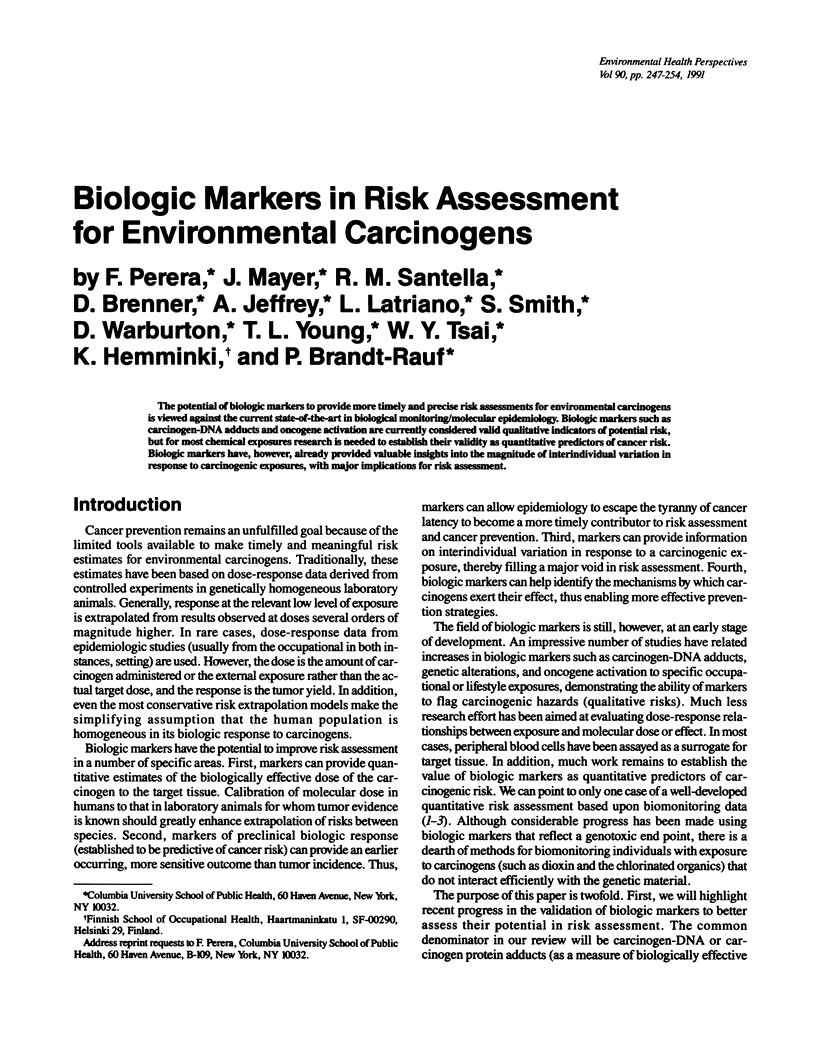
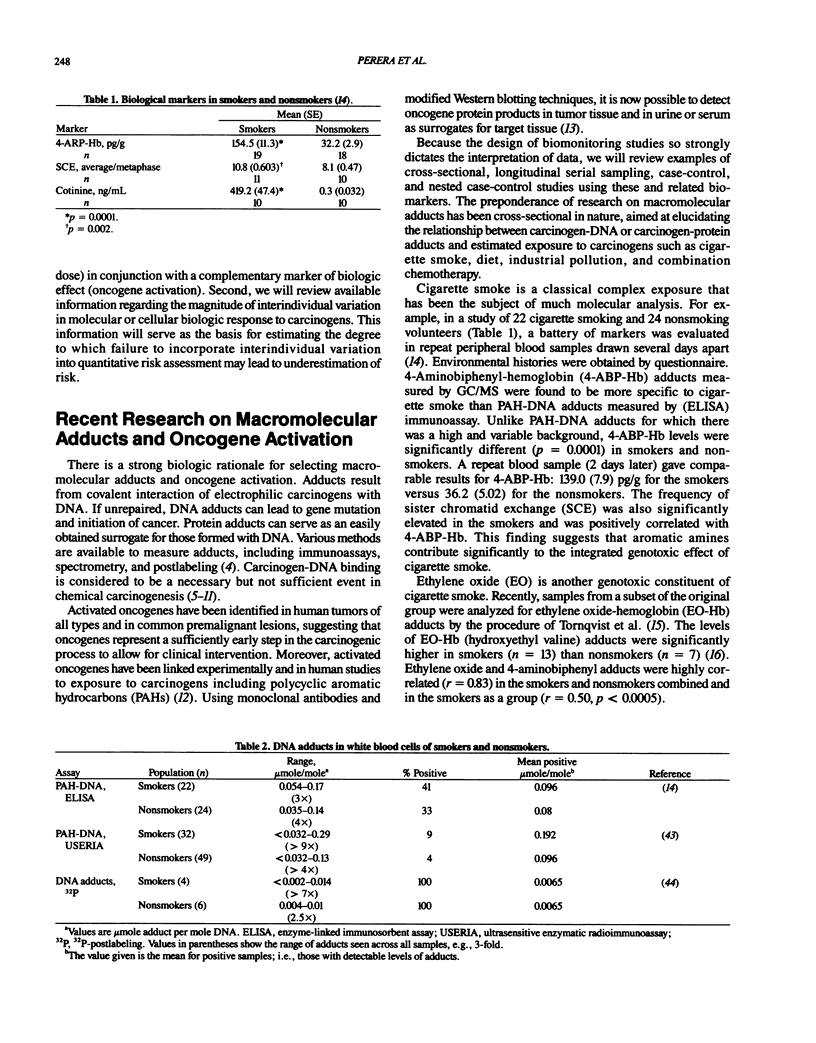
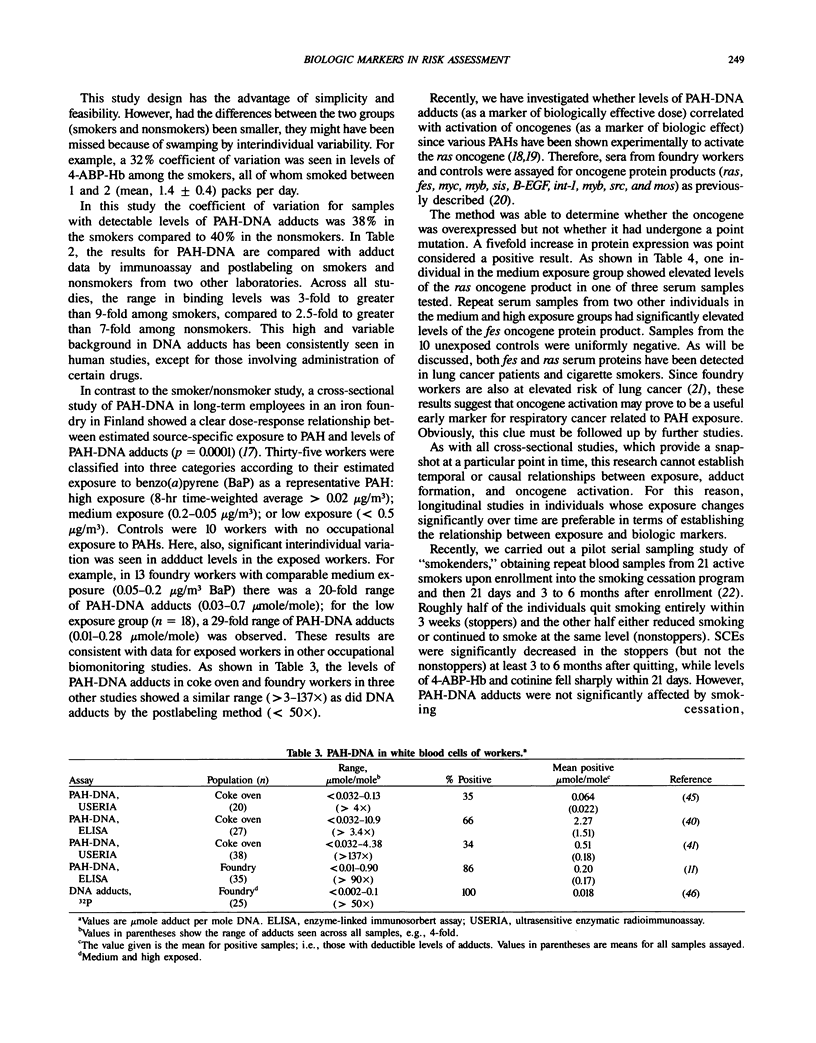


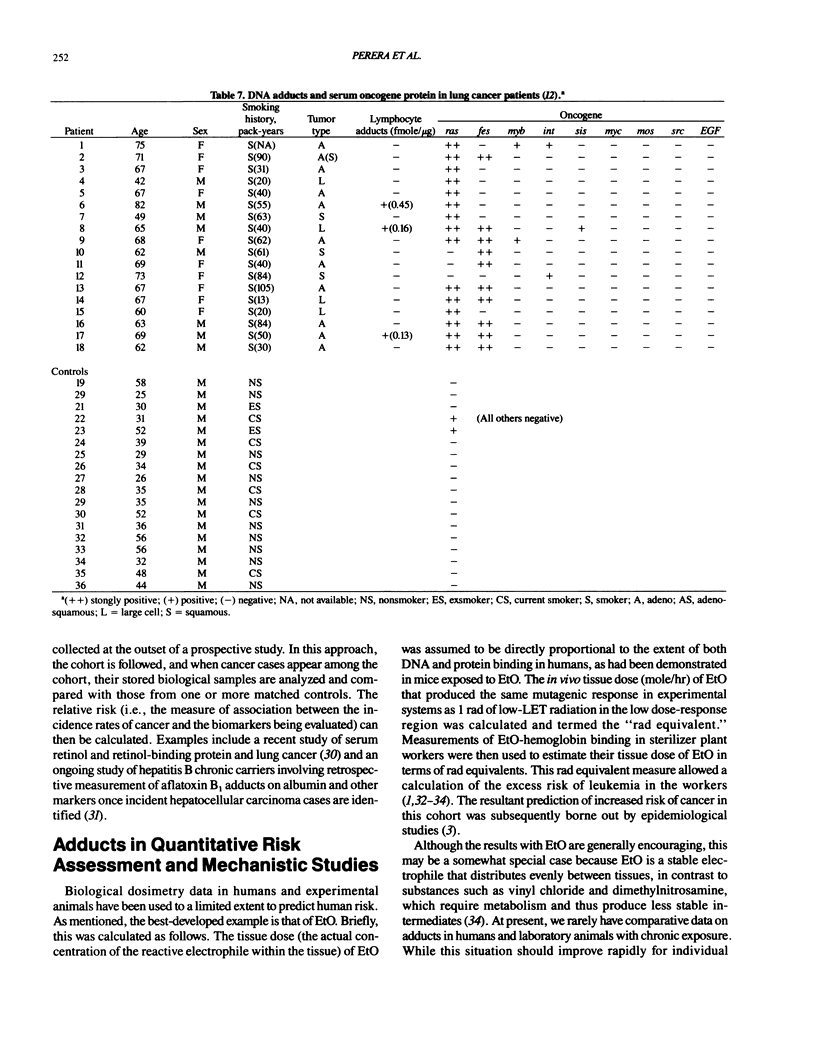
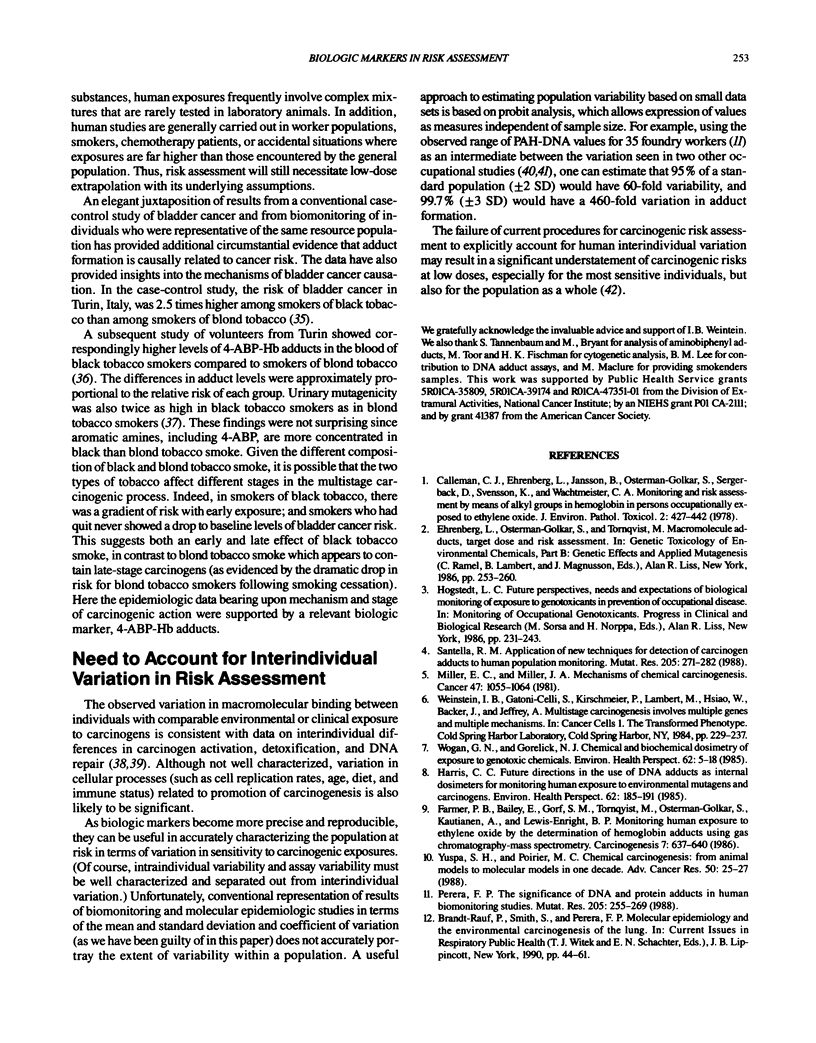

Selected References
These references are in PubMed. This may not be the complete list of references from this article.
- Balmain A., Pragnell I. B. Mouse skin carcinomas induced in vivo by chemical carcinogens have a transforming Harvey-ras oncogene. Nature. 1983 May 5;303(5912):72–74. doi: 10.1038/303072a0. [DOI] [PubMed] [Google Scholar]
- Brandt-Rauf P. W., Smith S., Perera F. P., Niman H. L., Yohannan W., Hemminki K., Santella R. M. Serum oncogene proteins in foundry workers. J Soc Occup Med. 1990 Spring;40(1):11–14. doi: 10.1093/occmed/40.1.11. [DOI] [PubMed] [Google Scholar]
- Bryant M. S., Vineis P., Skipper P. L., Tannenbaum S. R. Hemoglobin adducts of aromatic amines: associations with smoking status and type of tobacco. Proc Natl Acad Sci U S A. 1988 Dec;85(24):9788–9791. doi: 10.1073/pnas.85.24.9788. [DOI] [PMC free article] [PubMed] [Google Scholar]
- Calleman C. J., Ehrenberg L., Jansson B., Osterman-Golkar S., Segerbäck D., Svensson K., Wachtmeister C. A. Monitoring and risk assessment by means of alkyl groups in hemoglobin in persons occupationally exposed to ethylene oxide. J Environ Pathol Toxicol. 1978 Nov-Dec;2(2):427–442. [PubMed] [Google Scholar]
- Ehrenberg L., Hiesche K. D., Osterman-Golkar S., Wenneberg I. Evaluation of genetic risks of alkylating agents: tissue doses in the mouse from air contaminated with ethylene oxide. Mutat Res. 1974 Aug;24(2):83–103. doi: 10.1016/0027-5107(74)90123-7. [DOI] [PubMed] [Google Scholar]
- Farmer P. B., Bailey E., Gorf S. M., Törnqvist M., Osterman-Golkar S., Kautiainen A., Lewis-Enright D. P. Monitoring human exposure to ethylene oxide by the determination of haemoglobin adducts using gas chromatography-mass spectrometry. Carcinogenesis. 1986 Apr;7(4):637–640. doi: 10.1093/carcin/7.4.637. [DOI] [PubMed] [Google Scholar]
- Fichtinger-Schepman A. M., van Oosterom A. T., Lohman P. H., Berends F. Interindividual human variation in cisplatinum sensitivity, predictable in an in vitro assay? Mutat Res. 1987 Jan;190(1):59–62. doi: 10.1016/0165-7992(87)90083-2. [DOI] [PubMed] [Google Scholar]
- Friedman G. D., Blaner W. S., Goodman D. S., Vogelman J. H., Brind J. L., Hoover R., Fireman B. H., Orentreich N. Serum retinol and retinol-binding protein levels do not predict subsequent lung cancer. Am J Epidemiol. 1986 May;123(5):781–789. doi: 10.1093/oxfordjournals.aje.a114307. [DOI] [PubMed] [Google Scholar]
- Harris C. C. Future directions in the use of DNA adducts as internal dosimeters for monitoring human exposure to environmental mutagens and carcinogens. Environ Health Perspect. 1985 Oct;62:185–191. doi: 10.1289/ehp.8562185. [DOI] [PMC free article] [PubMed] [Google Scholar]
- Harris C. C. Interindividual variation among humans in carcinogen metabolism, DNA adduct formation and DNA repair. Carcinogenesis. 1989 Sep;10(9):1563–1566. doi: 10.1093/carcin/10.9.1563. [DOI] [PubMed] [Google Scholar]
- Harris C. C., Vahakangas K., Newman M. J., Trivers G. E., Shamsuddin A., Sinopoli N., Mann D. L., Wright W. E. Detection of benzo[a]pyrene diol epoxide-DNA adducts in peripheral blood lymphocytes and antibodies to the adducts in serum from coke oven workers. Proc Natl Acad Sci U S A. 1985 Oct;82(19):6672–6676. doi: 10.1073/pnas.82.19.6672. [DOI] [PMC free article] [PubMed] [Google Scholar]
- Haugen A., Becher G., Benestad C., Vahakangas K., Trivers G. E., Newman M. J., Harris C. C. Determination of polycyclic aromatic hydrocarbons in the urine, benzo(a)pyrene diol epoxide-DNA adducts in lymphocyte DNA, and antibodies to the adducts in sera from coke oven workers exposed to measured amounts of polycyclic aromatic hydrocarbons in the work atmosphere. Cancer Res. 1986 Aug;46(8):4178–4183. [PubMed] [Google Scholar]
- Kouri R. E., McKinney C. E., Slomiany D. J., Snodgrass D. R., Wray N. P., McLemore T. L. Positive correlation between high aryl hydrocarbon hydroxylase activity and primary lung cancer as analyzed in cryopreserved lymphocytes. Cancer Res. 1982 Dec;42(12):5030–5037. [PubMed] [Google Scholar]
- Kärki N. T., Pokela R., Nuutinen L., Pelkonen O. Aryl hydrocarbon hydroxylase in lymphocytes and lung tissue from lung cancer patients and controls. Int J Cancer. 1987 May 15;39(5):565–570. doi: 10.1002/ijc.2910390505. [DOI] [PubMed] [Google Scholar]
- Malaveille C., Vineis P., Estéve J., Ohshima H., Brun G., Hautefeuille A., Gallet P., Ronco G., Terracini B., Bartsch H. Levels of mutagens in the urine of smokers of black and blond tobacco correlate with their risk of bladder cancer. Carcinogenesis. 1989 Mar;10(3):577–586. doi: 10.1093/carcin/10.3.577. [DOI] [PubMed] [Google Scholar]
- Marshall C. J., Vousden K. H., Phillips D. H. Activation of c-Ha-ras-1 proto-oncogene by in vitro modification with a chemical carcinogen, benzo(a)pyrene diol-epoxide. Nature. 1984 Aug 16;310(5978):586–589. doi: 10.1038/310586a0. [DOI] [PubMed] [Google Scholar]
- Miller E. C., Miller J. A. Mechanisms of chemical carcinogenesis. Cancer. 1981 Mar 1;47(5 Suppl):1055–1064. doi: 10.1002/1097-0142(19810301)47:5+<1055::aid-cncr2820471302>3.0.co;2-3. [DOI] [PubMed] [Google Scholar]
- Mustonen R., Hietanen P., Leppälä S., Takala M., Hemminki K. Determination of cis-diamminedichloroplatinum (II) in plasma proteins and hemoglobin of cancer patients. Arch Toxicol. 1989;63(5):361–366. doi: 10.1007/BF00303124. [DOI] [PubMed] [Google Scholar]
- Neumann H. G. Analysis of hemoglobin as a dose monitor for alkylating and arylating agents. Arch Toxicol. 1984 Nov;56(1):1–6. doi: 10.1007/BF00316343. [DOI] [PubMed] [Google Scholar]
- Niman H. L., Thompson A. M., Yu A., Markman M., Willems J. J., Herwig K. R., Habib N. A., Wood C. B., Houghten R. A., Lerner R. A. Anti-peptide antibodies detect oncogene-related proteins in urine. Proc Natl Acad Sci U S A. 1985 Dec;82(23):7924–7928. doi: 10.1073/pnas.82.23.7924. [DOI] [PMC free article] [PubMed] [Google Scholar]
- Paigen B., Ward E., Reilly A., Houten L., Gurtoo H. L., Minowada J., Steenland K., Havens M. B., Sartori P. Seasonal variation of aryl hydrocarbon hydroxylase activity in human lymphocytes. Cancer Res. 1981 Jul;41(7):2757–2761. [PubMed] [Google Scholar]
- Perera F. P., Hemminki K., Young T. L., Brenner D., Kelly G., Santella R. M. Detection of polycyclic aromatic hydrocarbon-DNA adducts in white blood cells of foundry workers. Cancer Res. 1988 Apr 15;48(8):2288–2291. [PubMed] [Google Scholar]
- Perera F. P., Santella R. M., Brenner D., Poirier M. C., Munshi A. A., Fischman H. K., Van Ryzin J. DNA adducts, protein adducts, and sister chromatid exchange in cigarette smokers and nonsmokers. J Natl Cancer Inst. 1987 Sep;79(3):449–456. [PubMed] [Google Scholar]
- Perera F. P. The significance of DNA and protein adducts in human biomonitoring studies. Mutat Res. 1988 May-Aug;205(1-4):255–269. doi: 10.1016/0165-1218(88)90021-3. [DOI] [PubMed] [Google Scholar]
- Phillips D. H., Hemminki K., Alhonen A., Hewer A., Grover P. L. Monitoring occupational exposure to carcinogens: detection by 32P-postlabelling of aromatic DNA adducts in white blood cells from iron foundry workers. Mutat Res. 1988 Mar;204(3):531–541. doi: 10.1016/0165-1218(88)90047-x. [DOI] [PubMed] [Google Scholar]
- Phillips D. H., Hewer A., Grover P. L. Aromatic DNA adducts in human bone marrow and peripheral blood leukocytes. Carcinogenesis. 1986 Dec;7(12):2071–2075. doi: 10.1093/carcin/7.12.2071. [DOI] [PubMed] [Google Scholar]
- Reed E., Yuspa S. H., Zwelling L. A., Ozols R. F., Poirier M. C. Quantitation of cis-diamminedichloroplatinum II (cisplatin)-DNA-intrastrand adducts in testicular and ovarian cancer patients receiving cisplatin chemotherapy. J Clin Invest. 1986 Feb;77(2):545–550. doi: 10.1172/JCI112335. [DOI] [PMC free article] [PubMed] [Google Scholar]
- Santella R. M. Application of new techniques for the detection of carcinogen adducts to human population monitoring. Mutat Res. 1988 May-Aug;205(1-4):271–282. doi: 10.1016/0165-1218(88)90022-5. [DOI] [PubMed] [Google Scholar]
- Shamsuddin A. K., Sinopoli N. T., Hemminki K., Boesch R. R., Harris C. C. Detection of benzo(a)pyrene:DNA adducts in human white blood cells. Cancer Res. 1985 Jan;45(1):66–68. [PubMed] [Google Scholar]
- Törnqvist M., Osterman-Golkar S., Kautiainen A., Jensen S., Farmer P. B., Ehrenberg L. Tissue doses of ethylene oxide in cigarette smokers determined from adduct levels in hemoglobin. Carcinogenesis. 1986 Sep;7(9):1519–1521. doi: 10.1093/carcin/7.9.1519. [DOI] [PubMed] [Google Scholar]
- Vineis P., Esteve J., Hartge P., Hoover R., Silverman D. T., Terracini B. Effects of timing and type of tobacco in cigarette-induced bladder cancer. Cancer Res. 1988 Jul 1;48(13):3849–3852. [PubMed] [Google Scholar]
- Wogan G. N., Gorelick N. J. Chemical and biochemical dosimetry of exposure to genotoxic chemicals. Environ Health Perspect. 1985 Oct;62:5–18. doi: 10.1289/ehp.85625. [DOI] [PMC free article] [PubMed] [Google Scholar]
- Yuspa S. H., Poirier M. C. Chemical carcinogenesis: from animal models to molecular models in one decade. Adv Cancer Res. 1988;50:25–70. doi: 10.1016/s0065-230x(08)60434-0. [DOI] [PubMed] [Google Scholar]


